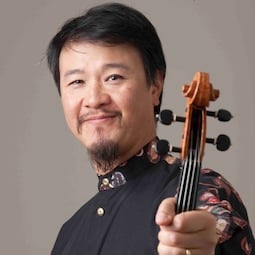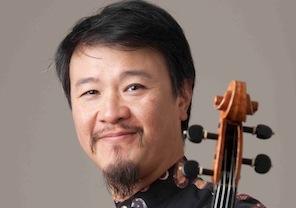
The Del Sol String Quartet has been championing contemporary classical and global music for 20 years now, yet it is still coming up with something new and different. For upcoming performances, this includes additional instruments, vocals, and dance. The quartet members — violinists Kate Stenberg and Rick Shinozaki, violist Charlton Lee, and cellist Kathryn Bates Williams — also are strongly committed to championing new composers and bringing music to kids … and others. Charlton Lee talks about his life as a musician, and how he got there, as well as what his group has planned for this upcoming weekend: It’s going to be busy.
You’ve got a busy weekend coming up, as you’ll be at Cabrillo [Festival of Contemporary Music, in Santa Cruz].
We’re also doing a performance of StringWreck, our collaboration with Garret + Moulton Productions, on Friday at the ODC Dance Moons. It’s stuff we’re doing in Europe, and we’re going to run the dance program. You can watch the video. We’re actually on stage with the dancers and it’s choreographed.
Featured Video
Related Article
Del Sol Quartet on the Edge at Cabrillo
Revelatory Cabrillo Festival Concert
That ties into a question I wanted to ask. You’re part of the choreography with dancers, and when you’re performing Chinary Ung’s Spiral X: In Memoriam, the musicians vocalize part of the score. It’s obviously unusual, but just how hard is it to add in something like vocalizations and movement when you’re playing?
It’s stuff no one else does. It’s physical. The vocalization is interesting because we are pitch-based musicians. String players control the pitch with their fingers, unlike piano or guitar where you “plunk” and you have the pitch. Our brains are hardwired to our fingers, and that’s how you hear the pitch and know where your fingers need to be. Adding that physical movement of singing at the same time means you’re controlling two pitches. It’s not obvious, except to other string players, but when we first tried to sing and play, our fingers moved. We had to develop new brain pathways. But I think it’s becoming more popular to add in vocalizations.
You must also have to develop new brain pathways to add the dance choreography, as well.
Yes, with the dancers we have to run around and play at the same time. I’m comfortable moving. Our cellist has ballet and other training, so she’s fine. Which is good, because she’s lugging around a massive instrument. She’s also playing while sitting on three dancers, who then move across the stage. It’s a poignant piece.
So what did you think when you got the score with the vocalizations?
Chinary first sent pieces of it. We knew it would be there. He asked for our pitch ranges, saying he wanted “to give color to the lines,” and said we would sing in the same pitches as the instruments. Then when we got it, it was huge, eight lines, much more than we expected.
It was nice to be involved in the composition. It is one of the advantages of working with living composers.
It’s a memoriam — Ung, a Buddhist, is commemorating those who died in the Cambodian genocide. The emotions in this piece must be very raw.
It is raw, but it’s a beautiful piece, one of our favorites. It’s easy to get into.
You’re also premiering Mason Bates’ Bagatelles for Amplified String Quartet and Electronica. How does the electronica part affect your playing as a quartet?
We’re very excited. It’s a lot of fun, but the electronica is unbending. It’s not like having a click track. Many places are extremely complex. We have to adjust to it and not it with us. We have to breathe with it. The electronica track has missing notes and cuts out, so we have to keep our time. All of the electronica track was made from sounds we had recorded for Mason. We were in the studio playing, asking things like “What happens if I draw my bow across the string like this?”
It was nice to be involved in the composition. It is one of the advantages of working with living composers. It’s a two-way street. Composers often send drafts and ask for feedback. I think that has given me a much broader insight into the “dead” composers. People turn their works into Bibles, but almost every composer tweaks their music and is open to making changes and adjustments.
What are some of the highlights of Cabrillo, for you?
We’ve never performed there before. I think it’s one of the premier new-music festivals. The work Marin [Alsop, the music director] has done is just fabulous.
A lot of composers that we work with will be there. One of the young composers is Dylan Mattingly. He’s a cellist as well, and a former student of our quartet. We have a workshop for kids ages 10 to 18 [QuartetFest], and he came in as a 10-year-old and came back every year. We saw his ability right away, but it’s great to see him fulfill his promise and have a career. Now, we’ve just commissioned a work from him. The quartet is turning 20, so we commissioned 12 works. It’s for 2012, turning 20 in the year ’12.
I wondered why 12, if it’s the 20th anniversary. Does it feel like 20 years?
It’s incredibly scary.
When did you start playing, and was it the viola?
I started to play violin at age 7. I switched to viola for quartets at music school. We had lost our viola, and I said I’d play viola, as violinists were a dime a dozen.
It seemed like a much more appropriate instrument for my personality and physicality. It was more comfortable, being larger than a violin and with a deeper sound.
Our mission is to bring the voice of living composers and artists to our community and make them part of modern life.
When did you know this was what you wanted to do?
I hadn’t planned to have a career in music. My undergraduate degree was in applied mathematics and physics at Cal Berkeley. I was searching for what to do after I graduated. I was accepted to grad school, had deferred, and was working in a physics lab. In fact, I just ran into my boss at the lab, and he says there are six papers published in Physical Review Letters that have my name on them. I’m probably the only musician in the world who’s been published in Physics Review Letters.
You probably don’t get into discussions of “string theory” with other musicians during breaks!
The big attraction with music is that I feel like it’s something immediately tangible and accessible (unlike higher-level physics), and you can share it with others.
I didn’t go back to music with the idea of becoming a professional, though. I was working long hours in the lab, and enjoying it, but since I was searching for where to go, I figured, Why not devote some serious time to studying music!
Are there other ways you might have gone?
I’ve devoted a lot of time to practicing tai chi over the past 20 years. That’s another track. There’s a lot out there.
What are some of the pluses and minuses of the music career?
Our mission is to bring the voice of living composers and artists to our community and make them part of modern life. I absolutely love the old composers, but people forget that they were the contemporary musicians of their time and that classical music as an art form has to continue to grow and evolve. You can’t just look at it as a museum piece. There are more composers writing today than ever before, and they should be heard.
It seems like it would be a challenge, but important, to reach those who don’t really know classical music.
I think some of the most difficult are the traditionalists. Those who know nothing about classical music are much more open. The trick is getting them to the concert. I’m hoping it will come at some point. Things can change overnight, and we’ll do our part.
As a career, it’s very rewarding. To share the music is wonderful.
The lifestyle is hard. I have three kids and a wife [pianist Eva-Maria Zimmerman]. It’s hard to find time, and hard financially. You’re always traveling. There’s always chaos; schedules change. It’s not like having a more settled and structured job.
Also, as a quartet, we’re running the business. There’s computer time, correspondence, applying for grants — so much work. We also have a nonprofit and need to work with the board.
Plus, every piece is a new world and a new musical language, and you need to get up to speed. But it’s very stimulating intellectually.
Are you listening to anything in particular, musically, now?
I like a broad range of music, jazz to pop and so on. But I like the quiet. Around here, someone’s always doing something. All three kids play piano and a string instrument. It’s hard to listen to music without turning on the working part of the brain, analyzing, and so on. The downtime gives my brain time to create.

